
21 minute read
Two-Faced Photographs Regenerated in Warp and Weft: Shan Goshorn’s Carlisle Baskets
Jacqueline Fear-Segal
Educational Genocide A unique and astonishing characteristic of Shan Goshorn’s work is the photographs that she weaves into traditional Cherokee baskets. When I asked her if anyone else has done this before, she said, “I’ve never seen any work like that.”1 What first drew Goshorn to my attention was seeing the panoramic photograph of the Carlisle Indian School student body (1912), woven around the deep rim of the lid of Educational Genocide; The Legacy of the Carlisle Indian Boarding School (fig. 1), just shortly after this basket had won the 2011 Red Earth Festival’s Grand Award for Best in Show.2 I was in the process of researching the Carlisle Indian School’s extensive photographic archive and exploring how Native artists are reclaiming and reframing some of these disturbing, colonial images.3 I was flabbergasted to discover that in Educational Genocide Goshorn had fused this nineteenth-century technology—photography—with the centuries-old tradition of Cherokee double-weave basket design. Educational Genocide measures almost two feet in length, and when looking at the image around the lid one can clearly make out the features of individual faces, the insignia and buttons of dark uniforms, and neat collars topping white blouses. The Olympic athlete Jim Thorpe was at the school in 1912, as was Goshorn’s great-grandmother. Goshorn came across the photograph hanging in her cousin’s restaurant in Cherokee, North Carolina. At this point, she had not yet woven any photographs, but she thought to herself, “That would wrap around a basket very nicely.” She borrowed the photograph and took it to Kinkos to make a scan, which she then used for her basket (figs. 2,3). Goshorn had only very recently started weaving seriously and had completed just one single-weave and one double-weave basket; Educational Genocide was only her third basket. When she told her Mom, “I’ve got this idea. . . . I think I’m going to try to weave a photograph into a basket,” her Mom just said, “Whaat!” Goshorn explains that a double-weave basket is one basket sitting inside another, joined around the rim (fig. 2). Construction starts on the interior bottom, and weaving continues up the sides to the desired height and then back down the sides to be finished on the bottom. When I asked her if the double-weave design has any particular function in telling this history, she reflected and replied, “I like the fact that this is a Cherokee basket. I also like the sturdiness; it has more presence, more weight, more sense of self.” The exterior of Educational Genocide is woven from beige paper splints printed with the words of the infamous “Kill the Indian in him, and save the man” speech made by Carlisle’s founder and first superintendent, Richard Henry Pratt (fig. 4).4 Goshorn has sliced up the text to create the splints. Individual words are still

1. Shan Goshorn, Educational Genocide; The Legacy of the Carlisle Indian Boarding School, 2011. Woven basket: archival inks and acrylic paint on paper. Montclair Art Museum, Montclair, NJ. Museum purchase, acquisition fund; 2015.12a, b. Photo: Peter Jacobs.
2. Educational Genocide, in the artist’s studio during weaving, Tulsa, OK, 2014.
OPPOSITE Shan Goshorn, Educational Genocide (detail), 2011, cat. 8. Photo: Peter Jacobs.


ABOVE TOP
3. Thompson Photo Co., Poughkeepsie, NY, Carlisle Indian Industrial School. Carlisle, Pa., 1912. Albumen print. National Anthropological Archives, Smithsonian Institution, Washington, DC.
BELOW LEFT
5. The artist working on Educational Genocide.
ABOVE
4. Detail of exterior of Educational Genocide.
BELOW RIGHT
6. Detail of interior of Educational Genocide.
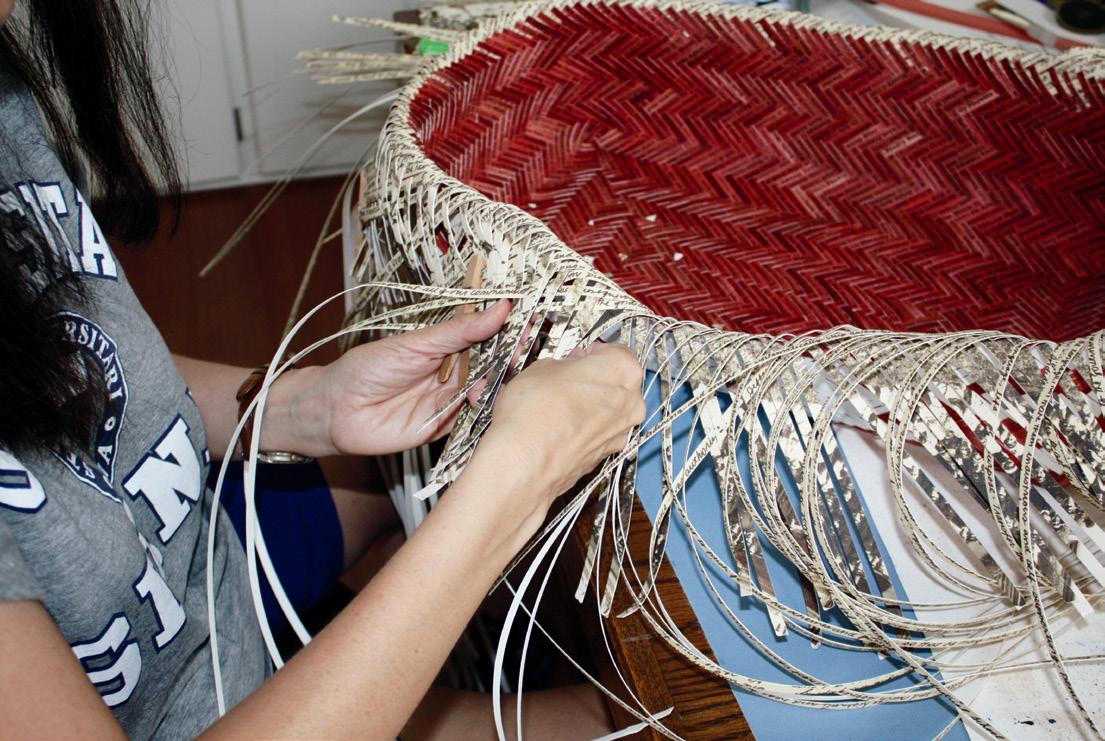

legible, but when integrated into this basket they contribute to a very different narrative (fig. 4). The interiors of basket and lid are bright red—the color of anger, blood, passion, and danger, but also love (figs. 5,6). And these interiors are woven out of thousands of paper splints, each of which carries the name of one of the more than 8,000 students who were enrolled at the school during its thirty-nine-year history. Shan Goshorn has done her research meticulously. The names of individual students, printed in the neat lettering of their Carlisle record cards, are clear and visible; but now they are enfolded by the double, protective sides of the basket, and shielded and safeguarded from voyeuristic view by the lid.5 Goshorn knows the importance of names. She recalls, “When I got into the Carlisle archives, I saw my great-grand parents’ names in the student roster. We had always known they had gone, but to see them listed . . . made it so real (figs. 7, 8).” Just as her ancestors would spend weeks locating and gathering the rivercane, white oak, and honeysuckle they needed to make their baskets, so too Goshorn needs time and expertise to acquire her materials. But instead of riverbanks and copses, Goshorn’s search grounds are archives and libraries, where she becomes a hunter-gatherer, harvesting written and visual documents as well as listening to conversations: “I gather information from everything that happens around me,” she explains, “That’s my preparation.” As a result of her research, Educational Genocide is multivocal. It incorporates a historical document outlining the genocidal mission of Carlisle, along with the bureaucratic record meticulously kept by the school on each and every one of the students, together with the human side of the story—visible in the photograph that shows the faces of the students. The basket draws in the viewer to marvel at the rendering of a photograph in warp and weft. It then delivers the realization that on this basket the students are not posed to demonstrate the success of the school, but instead to expose the pain and horror of a campaign that obliterated tribal names, reduced hundreds of traditional regalia to a single uniform, and forced children from disparate nations into an individual but regularized “Indian.” Combining the aptitude of the evidential historian with her weaving skills and artistic talent, Educational Genocide carries a strong message about the terrible cultural devastation that Carlisle and other boarding schools inflicted on Native peoples and the continuing legacies of these programs in Native communities today.
The Carlisle Indian School and Photography The founding of the Carlisle Indian School (1879–1918), the first US government boarding school, marked the beginning of the coordinated, state-run campaign of educational genocide that would be directed at all indigenous youth.6 Carlisle was an audacious experiment in cultural transformation, and it was here that the blueprint for the federal system of Indian schools was developed, and would be copied in Canada. Carlisle’s founder and first superintendent, Richard Henry Pratt, was a man with a mission; it is appropriate that his words and ideas are remembered by being incorporated into Goshorn’s baskets. After fighting Native nations who were defending their lands and lifeways on the Plains, Pratt was appointed by the US Army to be the jailor of captured warriors, imprisoned for three years (1875–78) at Fort Marion in Saint Augustine, Florida (fig. 9). Pratt opened a fortress school for the prisoners and became convinced that he had found the answer to the nation’s “Indian problem.” He insisted that if Native children were treated in the same way as the Florida prisoners and transported to schools far from their reservation communities, they could be stripped of all vestiges of their traditional cultures and readily reeducated in the religion, language, values, and behavior of
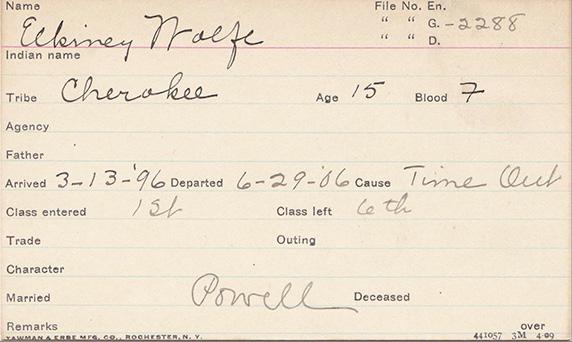

7. Carlisle Indian School Enrollment Record, Elkan(y) Wolf(e), Cherokee, 1906. Cumberland County Historical Society, Carlisle, PA.
8. Carlisle Indian School Enrollment Record, Moses Powell, Cherokee, 1904. Cumberland County Historical Society, Carlisle, PA.
9. George Pierron, The Kiowa Prisoners, 1875. Albumen prints mounted on stereo-card. Collection of Western Americana, Beinecke Rare Book and Manuscript Library, Yale University, New Haven, CT. Richard Henry Pratt Papers, MSS S-1174, box 23a, folder 746.
10. John N. Choate, Richard Henry Pratt with Twelve Navajo Students, Bandstand, Carlisle Indian School, Carlisle, Pennsylvania, 1882. Albumen print on card. Archives and Special Collections, Dickinson College. Carlisle Indian School, PC 2002.2, folder 3.
11. John N. Choate, Group of Eleven Navajo Students, 1883. Albumen print on card. Archives and Special Collections, Dickinson College. Carlisle Indian School, PC 2002.2, folder 4.

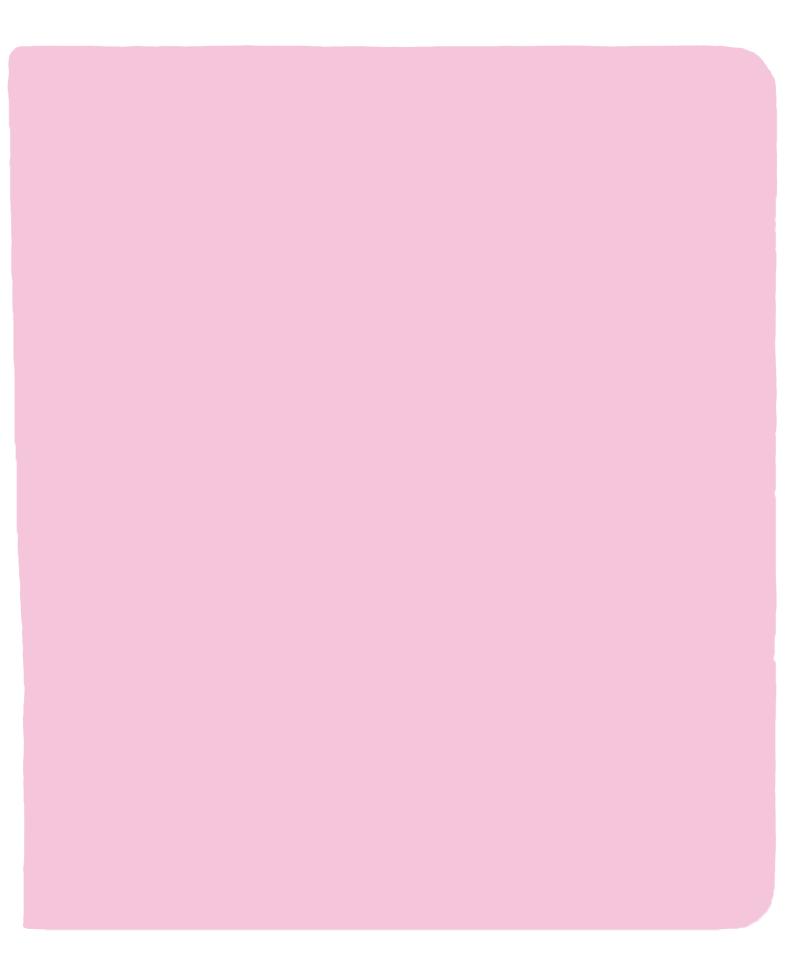
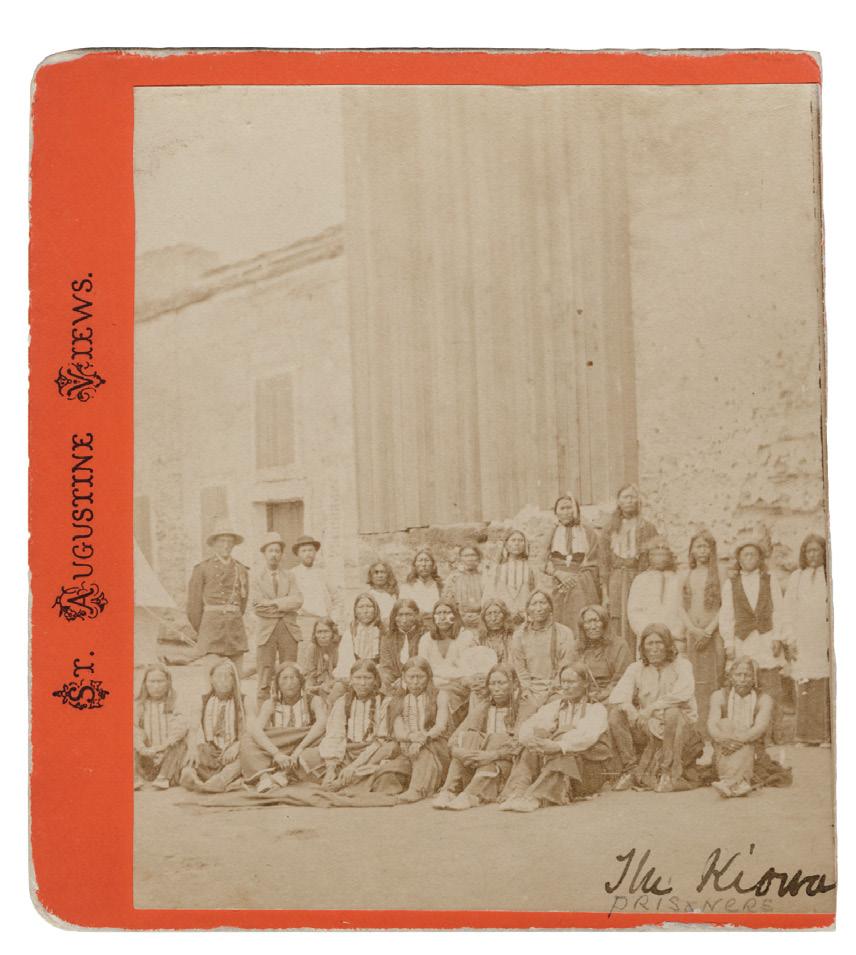

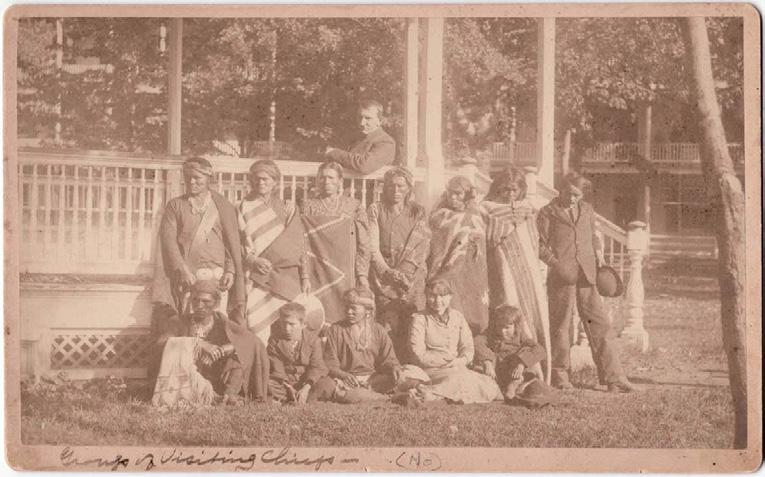

mainstream settler society. Pratt projected that at schools like Carlisle this transformation of the “Indian” from “savagery” to “civilization” could be accomplished in a single generation.7 His objective at Carlisle was twofold: first, to “civilize” Native children from across the United States in preparation for their assimilation; second, to demonstrate to skeptical Americans that this transformation was possible. From the first days of the Carlisle Indian School, Pratt recruited the new medium of photography to provide visual “proof” that the dramatic transformation he promised could indeed be rapidly achieved.8 A convincing public visual record was vital to his purpose. With the willing cooperation of local commercial photographer John Nicholas Choate, he carefully choreographed and assembled an extensive colonial photographic archive to document the “success” of his school. The morning after the midnight arrival of the first children, following their long journey from Dakota, Pratt made certain that Choate was on the campus with his stereoscopic camera and mobile studio to make the first photographs of the new students, still dressed in their regalia, with girls and boys grouped separately. Sometime later, Choate took pictures of these same groups in their uniforms. He then assembled the first before-and-after pairs (figs. 10, 11). Choate had quickly grasped the profit he could make from selling pictures of Indians, and he developed a commercial catalog of Indian School images totaling more than a hundred in under two years. These first before-and-after pairs always featured at the top of Choate’s commercial list. This commodification, described by cultural studies scholar Curtis Marez as “the photo-conversion of Indians into property,” thus permitted white voyeuristic ownership of images of Native students. Purchasing and possessing
these images, and perhaps arranging them in the plush albums so popular at the time, encouraged white Americans “to combine visual and tactile registers and take sensual pleasure in the imaginary experience of controlling or ‘owning’ Indians.”9 The huge and enduring popularity of images of Native peoples can in part be linked to an emotion that Renato Rosaldo has called “Imperialist nostalgia,” a paradoxical phenomenon linked to “mourning for what one has destroyed.”10 Choate profited from this emotion, and as he gained experience in photographing “Indians,” he honed his practice of the before-and-after genre by directly matching and naming the Carlisle students he included in the image duos, as well as by focusing on smaller groups, so that the constructed changes he presented could be more easily scrutinized. Despite the hundreds of photographs that Choate made of Carlisle’s students and activities, it was the before-and-after pairs that were most popular with white viewers and they became the photographic signature of the school, as well as an instrument of its propaganda. Mass-produced as albumen boudoir and cabinet prints, Pratt sent them out to the US president, congressmen, government officials, and prospective donors, and also offered them as “rewards” to any reader of the school’s Indian Helper who signed up ten new subscribers.11 At Choate’s downtown studio and on campus, the photographs were sold to members of the public. Intended to provide indisputable proof of the success of this federally sponsored campaign of cultural genocide, the before-and-after photographs carried a forthright message of a seemingly straightforward and easy transition from “savagery” to “civilization,” in binary pairs that elided all reference to the processes of change demanded by the school, and that totally disregarded the disruption, loss, and pain inflicted on the students, as well as subsequent generations. Despite their apparent simplicity, these photographs are highly complex visual constructions that carry covert narratives. Embedded in these photographic dyads is a new rendering of the “vanishing Indian.” Here, under the eyes of the viewer, instead of being subject to physical disappearance—the traditional solution12—individual tribes are rendered culturally extinct, a process described by Ted Jojola, an Isleta Pueblo, in an essay about boarding school images entitled “Photographs from Hell,” as “a magic act called ‘The Vanishing American.’”13 Reflecting on photography and how it has “abused” Native Americans, Anishinabe writer Gerald Vizener demands, “Photographers abused the native sense of privacy to capture an image and then either sold or distributed the pictures to various agencies. How should we now respond to photographs that have violated the privacy of the natives?”14
Before-and-After Photographic Baskets Shan Goshorn’s response to this question is to weave the Carlisle photographs into traditional Cherokee baskets.15 Goshorn is herself a distinguished photographer who has directly used the power of her camera to expose and combat visual racist stereotypes (figs. 12, 13).16 But she finds that her baskets have been much more effective in conveying the difficult messages she wants to communicate. “Up until I started making baskets,” she notes, “my work was very confrontational and people would wrap their arms around themselves and practically back out of a room, because they didn’t want to deal with that confrontation.” Reflecting on how that response has now changed, she observes:
There’s something about baskets…maybe it’s the familiarity of the shape—it’s a domestic vessel, they’re not threatening, they’re very nurturing—so I think people are intrigued. People literally lean into these baskets. Instead of backing up and separating and distancing themselves, they actually want to engage in this conversation.

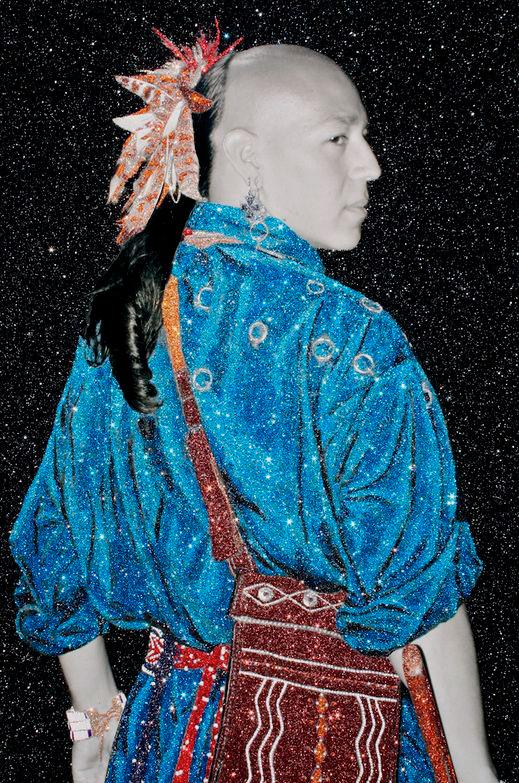
12, 13. Shan Goshorn, High Stakes; Tribes’ Choice #1 and #2, 2011. Digital photograph: archival pigments and glitter on paper.
14. Shan Goshorn, Alaskan Children (before/after) from Resisting the Mission; Filling the Silence, 2017. One of seven sets of baskets: archival ink, and acrylic paint on paper, polyester sinew. Artist’s collection.

The conversation she hopes to open up through her Carlisle baskets directly engages Native peoples, but Goshorn also wants “the general public to be educated about this history and about the terrible impact it has had on tribal cultures.…I’m stunned by how many people in America are still just so surprised that there are Indians left… so unaware. Our history is not taught in schools.” Like Educational Genocide, the exteriors of the before-and-after baskets that make up her most ambitious series of baskets—Resisting the Mission: Filling the Silence—are woven from the words of Pratt’s “Kill the Indian” address, and their red interiors are made from splints carrying the students’ names (fig. 14). While creating this series, Goshorn engaged directly with members of the communities who have been affected by the historical trauma instigated by Carlisle’s program and who have experienced firsthand the enduring legacies of cultural destruction.
Sending the before-and-after images out to communities and carrying them with her on her travels, she invited descendants to inscribe their own thoughts and feelings directly onto the photographs (figs. 15, 16). Then she cut the images into splints and wove them into seven pairs of Cherokee single-weave baskets, each standing nearly two feet high. The photographic pairs Goshorn selected for these baskets cover the wide range of Native nations enrolled at Carlisle—Inuit, Lakota, Pueblo, Apache, Navajo. The school included representatives from almost every single Native nation whose lands were incorporated into the United States; few were left untouched by its genocidal mission. Navajo/Diné student Hastiin To’Haali, known at Carlisle as Tom Torlino, arrived at Carlisle in 1882. 17 He is one of twelve Navajo posed for a photograph on the school bandstand with Pratt (see fig. 10).18 There is also a solo portrait of him; the only before-and-after pair that Choate made of an individual student (figs. 17, 18). When members of the public have been made aware of the history of Indian boarding schools, including Carlisle, it is often after seeing Torlino’s before-and-after photographs.19 These iconic Carlisle images were used to demonstrate the “marked contrast between a Navajo as he arrived in native dress, and as he now looks, and worth 20 cents a piece.”20 Created by carefully cropping a three-quarter length portrait so that it closely matched the image made of Torlino three years earlier, Choate succeeded in displaying striking changes in Torlino’s dress, hair, ornamentation, gaze, and even skin color, all of which served to made his supposed transformation appear particularly dramatic. As with all such duos, the visual narrative embedded in this pair of photographs powerfully suggested that a dramatic change had taken place and deftly implied that the exhibited exterior changes had been matched by analogous interior changes. Responding to Torlino’s persistent exploitation through the misuse of his teamed photographic images, in Two Views Shan Goshorn refutes Carlisle’s binary message by weaving a portrait that unites and merges these two photographs (fig. 19). “I wanted to show the division in this one person,” Goshorn explains. The portrait nestled in this basket is mesmeric; the extraordinary resilience demanded of Torlino is suggested by the serene power that seems to radiate from his face. Torlino’s bureaucratic Carlisle record is reproduced in the tan splints that encircle this basket (fig. 20). But Goshorn does not allow his story to end with Carlisle. After his four years at the school, Torlino returned to Coyote Canyon, New Mexico, to resume his traditional studies and to serve as medicine man to his people until he died. So, unlike the original before-and–after photographs, Goshorn’s basket embraces his whole life, with the later period being described by his great-great-granddaughter, Nonabah Sam. Her handwritten account is written on the basket’s rust colored splints, which speak of the continuing impact of Torlino’s years at Carlisle on his Diné family, who respect education but remain true to Diné teachings, as was his wish. (Interestingly, Choate had made his long hair a striking feature of Torlino’s “before” photograph, but Goshorn discovered from his relatives that Torlino kept his hair short for the rest of his life.) The basket’s white, black, blue, and yellow splints carry a Navajo prayer for wellbeing in the four sacred colors, but the irregular blackbird-eye pattern of the basket references the discomfort and divisions internalized by many students. All the photographs woven into these baskets were made by Choate in Carlisle. Either the students visited his studio at 21 Main (High) Street, 500 yards from The Trout Gallery or were photographed on the Carlisle Indian School campus (now the US Army War College), just two miles up the road. In an era when hundreds of Carlisle images are now available online, Goshorn is intensely aware of the importance of the photographic encounter and the saliency of the physical photograph. “It’s very different when you hold the image…because that photo
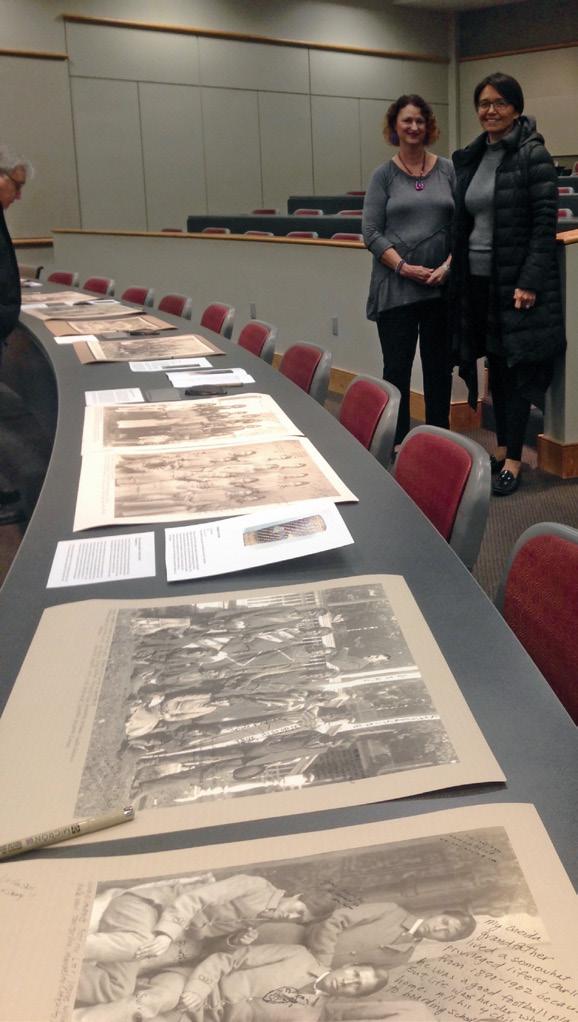
15. Prints for Resisting the Mission: Filling the Silence, assembled for signing, Tulsa, OK, 2016.
16. Detail of Eskimo Children, with inscriptions, for Resisting the Mission; Filling the Silence, 2016.
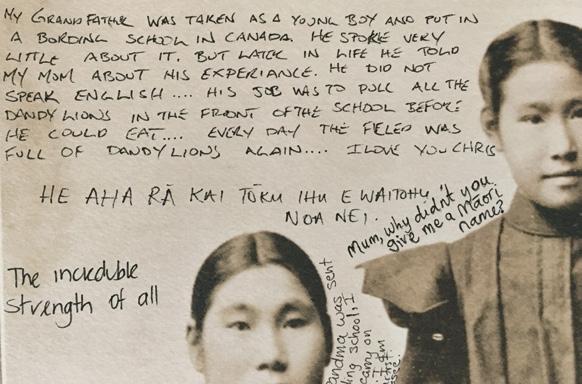
17. John N. Choate, Tom Torlino (upon arrival at Carlisle), c. 1882. Albumen print on card. National Archives and Records Administration, Washington, DC, RG 75, series 1327, box 18, folder 872.
18. John N. Choate, Tom Torlino (three years later), c. 1885. Albumen print on card. National Archives and Records Administration, Washington, DC, RG 75, series 1327, box 18, folder 872.
19. Detail of Two Views.
20. Shan Goshorn, Two Views, 2018. Woven basket: archival ink and acrylic paint on paper, polyester sinew. The Trout Gallery, Dickinson College. Purchased with funds from the Friends of The Trout Gallery, 2018.12. is literally the link between the photographer’s eye and the subject…so that really informed my research process.” The photographs of these students have now returned to Carlisle, the place where they were made. In this exhibition, Resisting the Mission, Shan Goshorn entirely transmutes the meaning of “before” and “after.” She invites us to position Choate’s photographic duos as the “before,” with her Cherokee baskets being the “after.” Now integrated and carried in a traditional craft form, the photographs are no longer instruments of propaganda. They can offer a means for Native and non-Native audiences alike to view, ponder, and begin to understand the history of Carlisle and its legacies.
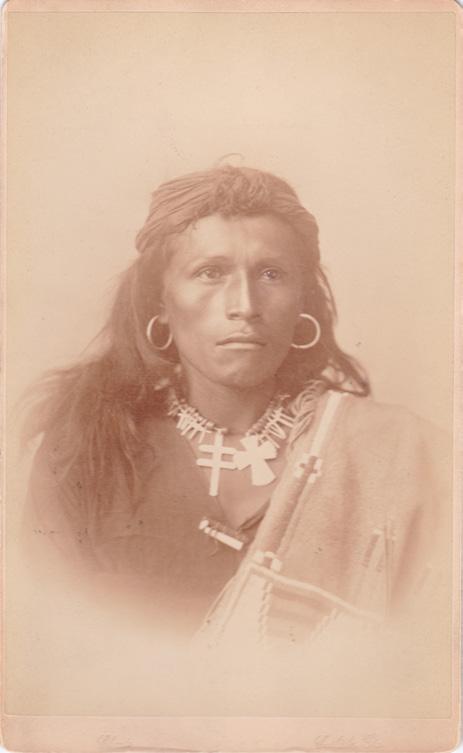

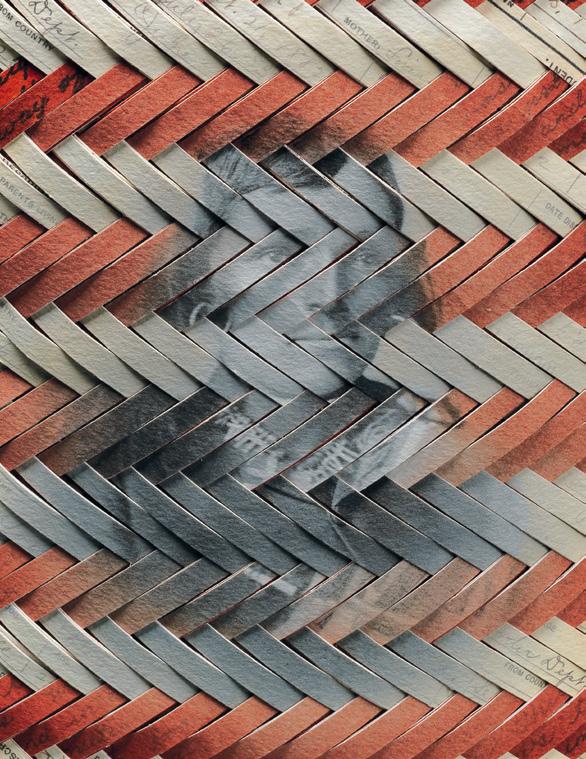

1. Shan Goshorn, interview by the author, November 15, 2016, Frankfurt, Germany. All Goshorn quotations are from this interview.
2. Red Earth is the primary multicultural resource in Oklahoma for advancing the understanding and continuation of traditional and contemporary Native culture and art. It was founded in 1978 with the establishment of the Center of the American Indian in Tulsa, a museum dedicated to promoting the rich traditions of American Indian arts and cultures through education, a premier festival, a museum, and fine art markets. In 1987, a group of influential community and tribal leaders founded the Red Earth Festival to showcase Native dance and art. The two groups merged in 1992 to create Red Earth, Inc.
3. E.g., Dorothy Grandbois, Crucifixion, 1994, digital photo-print on canvas; Steven Deo, Indoctrination #3, 2000, mixed media; and N.
Scott Momaday, Carlisle, 2012, acrylic on board.
4. Official Report of the Nineteenth Annual Conference of Charities and
Correction (1892), 46–59, repr. in Richard H. Pratt, “The Advantages of Mingling Indians with Whites,” Americanizing the American Indians:
Writings by the “Friends of the Indian,” 1880–1900, ed. F. P. Prucha (Cambridge, MA: Harvard University Press, 1973), 260–71.
5. With close observation, one can make out the names of specific individuals (for example, Mary Hunter (Caddo) and Nellie Hollie Cloud (Rosebud Oglala). It should be noted that Shan Goshorn conducted her research for Educational Genocide before the student records had all been made available online by Dickinson College’s Carlisle Indian School Digital Resource Center, http://carlisleindian.dickinson.edu/.
6. David Wallace Adams, Education for Extinction: American Indians and the Boarding School Experience, 1878–1928 (Lawrence: University
Press of Kansas, 1995).
7. For Pratt’s own account of his founding and running of the Carlisle
Indian School, see Richard Henry Pratt, Battlefield and Classroom:
Four Decades with the American Indian, 1867–1904, ed. Robert
Marshall Utley (New Haven, CT: Yale University Press, 1964).
8. On before-and-after imagery, see the essay by Phillip Earenfight in this volume.
9. Curtis Marez, “Looking Beyond Property: Native Americans and
Photography,” Rikkyo American Studies 29 (March 2007), www. academia.edu/8671758/Looking_Beyond_Property_Native_
Americans_and_Photography.
10. Renato Rosaldo, Culture & Truth: The Remaking of Social Analysis (Boston: Beacon Press, 1993), 69. 11. Preserved in the Hayes presidential archive, the first student beforeand-after images were among the more than three dozen photographs Pratt sent to the president, which today are held in the Lucy Webb Hayes Photograph Collection (Hayes-Ph-2), Rutherford B. Hayes Presidential Library, Ohio; Indian Helper 5, no. 12 (November 8, 1889).
12. General Philip Sheridan is supposed to have first spoken the apocryphal and oft-repeated words, “The only good Indians I ever saw were dead.”
13. Ted Jojola, “Photographs from Hell,” in Beyond the Reach of Time and Change: Native American Reflections on the Frank A. Rinehart
Photograph Collection, ed. Simon J. Ortiz (Tucson: University of
Arizona Press by arrangement with Haskell Indian Nations University, 2004), 79.
14. Gerald Robert Vizenor, Fugitive Poses: Native American Indian Scenes of Absence and Presence (Lincoln: University of Nebraska Press, 2000), 162.
15. We know the abuse went far beyond cultural obliteration. The revelations of Canada’s Truth and Reconciliation Commission have made public the horrifying extent of all levels of abuse inflicted on Native children attending residential schools. In Canada, as in the US, there were no safeguards in place to protect them.
16. Leon Grodski de Barrera, “Taking Ownership: Exhibit Explores the
Exploitation of Native American Stereotypes, Smoky Mountain News,
October 13, 2010, accessed July 28, 2018, http://www.smokymountainnews.com/news/item/1957-taking-ownership-exhibit-explores-the-exploitation-of-native-american-stereotypes.
17. Cindy Yurth explains that Tom Torlino was a mistranscription of his
Navajo name, Hastiin To’Haali; Yurth, “Manuelito’s Legacy,” Navajo
Times, February 14, 2013, accessed July 28, 2018, http://www.navajotimes.com/news/chapters/021413coy.php.
18. He attended the Carlisle Indian School from October 21,1882, to
August 28, 1886; Tom Torlino Student File, accessed July 28, 2018, http://carlisleindian.dickinson.edu/sites/all/files/docs-ephemera/
NARA_1327_b018_f0872.pdf.
19. See Bill Bigelow, ed., Rethinking Our Classrooms: Teaching for Equity and Justice, vol. 2 (Milwaukee, WI: Rethinking Schools, 2001).
20.Indian Helper 5, no. 12 (November 8, 1889).






